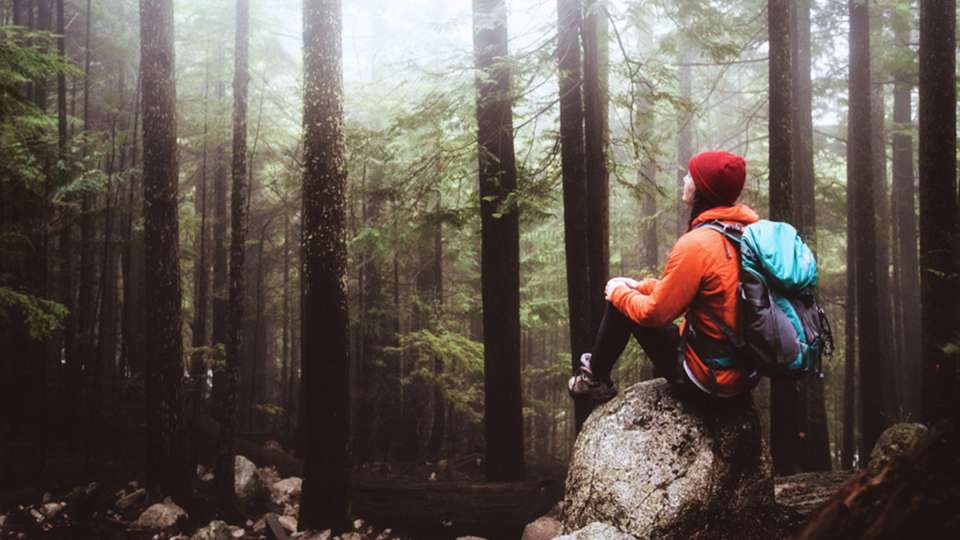
Adventure is out there, but what if your summer day hike takes a turn for the worse? All of a sudden, you find yourself injured or lost with no way of getting back to the trailhead.
What should you do?
“First of all, don’t panic,” says Dr. David Townes, an emergency medicine physician at UW Medical Center – Montlake, who also specializes in wilderness and expedition medicine. “It all comes down to being prepared and being pragmatic.”
To make sure you’re ready for this worst-case scenario, Townes shares his essential wilderness survival tips for Pacific Northwesterners.
Pack for emergencies
You might have only planned on hiking for a few miles in the Cascades, but that doesn’t mean you can toss a bottle of water and a granola bar into your backpack and call it good. It’s important to keep emergency essentials with you, no matter how short or easy your planned hike.
“In a lot of ways, it comes down to the basics of food, water and shelter,” Townes says.
He suggests keeping a water filter or water-purifying drops or tablets, extra food like energy bars or gels, an emergency blanket, waterproof matches and a first aid kit in your pack at all times.
While this might seem like overkill, these are items that take up minimal space and may pay off big in an emergency.
If you’re planning a longer trip or one in the backcountry, you may also want to consider purchasing a personal locator beacon or taking a look at the National Park Service’s list of 10 essential items to pack for a hike.
Leave your plans with a friend
Before you set off for the trailhead, it’s also important to inform a family member or friend.
“Leave them your detailed plans, like where you’re going, when you expect to be back, where you plan to park your car and what trail or route you’re doing and when,” Townes says. “Tell them that if you’re not back by a certain time that it means something is wrong.”
That way, if you don’t check in with them by the designated time, they know to inform the authorities that you’re missing. It also gives search and rescue a starting point for where you may be so they have a better chance of finding you.
Treat injuries as best you can
One minute you’re looking up at blue skies and towering trees, the next you’re tumbling down a rockface. Injuries can happen with one misstep, especially in rugged, wet or heavily forested terrain.
But there’s a reason you packed that first aid kit, remember?
Before you set out on a trip, make sure you’re familiar with how to use everything in your first aid kit. And if you really want to be prepared, consider taking a wilderness first responder course so you know how to treat injuries on the fly or download the Red Cross’s free first aid app.
Once you’re out there and dealing with an injury — whether your own or someone else’s — put all that first aid preparation to good use. Try to stop any bleeding from wounds and stabilize broken bones or sprains.
Still, you should also be comfortable with improvising. While you might have packed an elastic bandage wrap and maybe even an aluminum splint, that doesn’t mean you shouldn’t try using a branch as a makeshift crutch if needed.
“Treating injuries in the wild is a combination of preplanning and spontaneous improvisation,” Townes says.
Assess your situation
Let’s say you’re lost or injured. Should you stay put or try to find your way back to the trail? If you’re with someone else, should you split up or stick together?
It all comes down to your specific situation as well as the people in your hiking party, Townes says.
For example, if you’re a party of two and one of you is injured, you have to consider things like the extent of the injury and the resiliency of the injured person. Would they be able to tough it out on their own, or do they need help and support?
What type of trail you’re on and what time of year can also factor into your decision. If it’s a popular trail, in season, chances are other hikers will come along, making you may more inclined to stay put. But if you’re in a more remote area or in the off season, you may need to go for help.
If you do decide to keep moving and find help, Townes says there are two approaches: go uphill or go downhill.
“If the terrain allows and you can see above the tree line, then going up to see where you are is one approach,” he explains. “The downhill approach is assuming that you’ll eventually get to a river, and if you follow a river, you will probably find a trailhead to help you get back to civilization.”
Find or build shelter
When you’re outdoors for an extended period of time, the main concern becomes the elements.
“Wind and rain are the things that kill you because you get hypothermic,” Townes says. “Even if you’re just a little wet, you may get very cold, very quickly.”
If the weather conditions are deteriorating and night is falling, prioritize finding shelter. It can be as basic as taking cover behind a large rock or tree trunk that can shield you from the wind, or it can be as elaborate as fashioning a structure out of branches.
Still, it’s important to adapt to your unique situation.
“If it’s 70 degrees and dry, finding shelter is less of an issue,” Townes explains.
Identify clean water
While you’ve hopefully packed a water filter or water-purifying drops or tablets — or both — the next step is finding a clean water source.
In the Pacific Northwest, that’s usually not too much of a problem, even in the height of summer. Head downhill where you can likely find a river or other running water source.
“Moving, clear-looking water is better than stagnant water, and cold water is better than warm water,” Townes notes. “Collecting snowmelt or rainwater is even better.”
No matter how clean the water looks, though, you should still purify it if you can because water can have bacteria or microscopic parasites that can harm you.
That said, if you’re in the wild and have no way to clean your water, you can try some makeshift methods like straining it through a T-shirt or collecting it in a basin and skimming the cleaner water off the top.
It won’t be ideal and may still have bacteria in it, but these techniques can hopefully reduce the amount of harmful stuff in whatever you drink.
Most importantly, Townes says, whenever you reach a water source, top off all your water containers. You never know when you’ll be able to find water again, especially if you’re lost and trying to hike your way out.
Practice fire safety
Knowing how to build — remember those handy waterproof matches? — and maintain a fire can be helpful, especially if you’ve been lost for a while and need to cook food or keep warm.
That said, it’s equally important to practice fire safety, especially during wildfire season.
Clear the area around which you’re planning to build your fire, and make sure to keep your pack and other items away from the flames. The wind can easily pick up embers and light things on fire.
If you’re sleeping next to a fire, you also want to be upwind so that smoke inhalation and flying embers don’t become an issue.
And if you’ve had to replenish your food supply with fishing or hunting, make sure to cook your meal at least a few hours from where you plan to sleep.
“If you eat dinner, especially if you cook something, plan to hike two more hours after that where you want to sleep because the smell can linger and attract animals,” Townes explains.
React safely to wildlife
Speaking of animals, Washington is home to a few different types of wildlife that you may encounter, including black bears, grizzly bears and cougars.
The easiest way to prevent an interaction is to make noise as you walk. One way to do this is to attach a bear bell to your pack.
“If you’re noisy enough, they’ll avoid you,” Townes says. “They don’t want a direct encounter either.”
There are instances, however, when you may find yourself in an aggressive face-to-face situation with an animal. This is usually if you’ve surprised it or accidentally separated it from its young or food source.
If you’re facing a grizzly bear — differentiated by their shoulder hump, long claws and short, round ears — identify yourself as a human and not a prey animal by talking to it calmly and backing up slowly.
If you’re facing a black bear, talk to it loudly while waving your arms or opening up your jacket to make yourself appear larger. If you’re with others, stand side by side to make yourselves appear as large as possible. Move away slowly, but don’t turn your back to the bear. Most importantly, don’t run away as this can cause the bear to attack.
In the event that the bear does attack, how you respond will depend on the type of bear it is.
With grizzly bears play dead by laying on your stomach and protecting your neck. It’s best to remain still until the bear leaves, but if the attack persists, fight back as best you can.
With black bears, on the other hand, do not play dead. Instead fight back with whatever you can find and concentrate your hits and kicks on its face.
Respond to a cougar attack as you would a black bear attack: fight back and be aggressive.
The bottom line
Although it may seem unlikely that you need wildlife survival skills if you’re just planning a breezy day hike, the truth is that being prepared never hurts.
“People usually get into trouble because they’ve underestimated the hike or overestimated their abilities,” Townes says. “Be realistic with what you’re planning to accomplish and plan accordingly.”

 Healthy ideas for your inbox
Healthy ideas for your inbox





